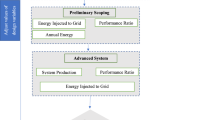Abstract
Universally, solar power microsystem for mini-grid is acceptable as a new approach to solve the global energy problem. Improving population lifestyle as well as the economy of a country will be difficult without Electricity. This study describes Design and installs Solar Power Microsystem to electrify Inbingan Village and Bawdigone/ChiYarPinSu/Zeephyjim/Payagone Village in Myanmar and to provide lighting and public electricity to a total of 560 families has been participating in the study. This study is conducted with International Cooperation and Development Fund (“TaiwanICDF”) based on the equest from Department of Rural Development (“DRD”) of Ministry of Agriculture, Livestock and Irrigation of the Government of the Republic of the Union of Myanmar. In this paper, Solar Power Microsystem of Mini-Grid Design and Planning, Main Solar Power Microsystem System Equipment and LED Lights Specification Requirements and development of a Financially Viable Operating Model and Suitable Financing Mechanisms for extending rural solar power microsystem for mini-grid systems are presented. Battery storage is used to adjust the operation strategies and bring in different economic benefits. HOMER software package developed by NREL is used for designing and simulating the general system of each village. This paper proposes and implements the electrification strategies for a variety of consumer load types in the two-selected area in the Myanmar. This research is to consider the electrification strategies based on: cost, efficiency, performance, equipment utilization factor, excess electricity produced etc. Based on the findings from the study; the systems improved the nighttime reading environment for schoolchildren, extended the time spend by villagers in home economic activities, and improved interpersonal relationships between villagers, the project saved money on purchasing candles or kerosene. In addition, the paper will provide insight into suitability of such strategies and act as a guideline for balancing cost optimization process and design robustness of such systems. It will also provide recommendations on future research along this line, which would include aspects that could not covered in this work.






Similar content being viewed by others
References
Alam M, Bhattacharyya S (2016) Decentralized renewable hybrid mini-grids for sustainable electrification of the off-grid coastal areas of Bangladesh. Energies 9(4):268. https://doi.org/10.3390/en9040268
Asian Development Bank (2017) Developing renewable energy mini-grids in Myanmar - A guidebook. https://doi.org/10.22617/TIM178951
Azimoh CL, Klintenberg P, Wallin F, Karlsson B, Mbohwa C (2016) Electricity for development: mini-grid solution for rural electrification in South Africa. Energy Convers Manag 110:268–277
Bhattacharyya SC (2015) Mini-grid based electrification in Bangladesh: technical configuration and business analysis. Renew Energy 75:745–761 (Institute of Energy and Sustainable Development, De Montfort University, Leicester LE1 9BH, UK)
Bhattarai PR, Thompson S (2016) Optimizing an off-grid electrical system in Brochet, Manitoba, Canada. Renew Sust Energy Rev 53:709–719
Chaujar R, Pandey R (2016) Novel back-contact back-junction SiGe (BC-BJ SiGe) solar cell for improved power conversion efficiency. Microsyst Technol 22:2673 (Springer Berlin Heidelberg)
Cruz-Campa JL et al (2011) Microsystems enabled photovoltaics: 14.9% efficient 14 mm thick crystalline silicon solar cell. Solar Energy Mat Solar Cells 95:551–558
Gamarra C, Guerrero JM (2015) Computational optimization techniques applied to microgrids planning: a review. Renew Sust Energy Rev 48:413–424
Ghatikar G, Mashayekh S, Stadler M, Yin R, Liu Z (2016) Distributed energy systems integration and demand optimization for autonomous operations and electric grid transactions. Appl Energy 167:432–448
Giannoulis ED, Haralambopoulos DA (2011) Distributed generation in an isolated grid: methodology of case study for Lesvos–Greece. Appl Energy 88:2530–2540
Gupta VP, Cruz-Campa JL, Okandan M, Nielson GN (2010) Microsystems—enabled photovoltaics: a path to the widespread harnessing of solar energy. Future Photovolt 1(1):28–36
Hafez O, Bhattacharya K (2012) Optimal planning and design of a renewable energy based supply system for microgrids. Renew Energy 45:7–15
Huld T, Moner-Girona M, Kriston A (2017) Geospatial analysis of photovoltaic mini-grid system performance. Energies 10:218. https://doi.org/10.3390/en10020218
Khodayar Mohammad E (2017) Rural electrification and expansion planning of off-grid microgrids. Electr J 30(4):68–74
Kim H, Baek S, Park E, Chang HJ (2014) Optimal green energy management in Jeju, South Korea—on-grid and off-grid electrification. Renew Energy 69:123–133
Ling JM, Liu PH (2018) The performance analysis of photovoltaic generation using the improved incremental conductance method under varying solar irradiance. Microsyst Technol 24:235 (Springer Berlin Heidelberg 0946-7076)
Ogbonnaya E, Gunasekaran A, Weiss L (2013) Micro solar energy harvesting using thin film selective absorber coating and thermoelectric generators. Microsyst Technol 19:995 (Springer-Verlag)
Olivares DE, Cañizares CA, Kazerani M (2011) A centralized optimal energy management system for microgrids. In: Proceedings of IEEE PES General Meeting, pp 1–6. http://citeseerx.ist.psu.edu/viewdoc/download?doi=10.1.1.699.5735&rep=rep1&type=pdf
Pedersen MB, Nygaard I (2018) System building in the Kenyan electrification regime: the case of private solar mini-grid development. Energy Res Soc Sci 42:211–223 (UNEP DTU Partnership, DTU Management Engineering, UN City, Marmorvej 51, 2100 Copenhagen, Denmark)
Ramli MAM, Hiendro A, Sedraoui K, Twaha S (2015) Optimal sizing of grid-connected photovoltaic energy system in Saudi Arabia. Renew Energy 75:489–495
Sen R, Bhattacharyya SC (2014) Off-grid electricity generation with renewable energy technologies in India: an application of HOMER. Renew Energy 62:388–398
Siddaiah R, Saini RP (2016) A review on planning, configuration, modeling and optimization techniques of hybrid renewable energy systems for off grid applications. Renew Sust Energy Rev 58:376–396
Soshinskaya M, Crijns-Graus WHJ, Guerrero JM, Vasquez JC (2014) Microgrids: experiences, barriers and success factors. Renew Sust Energy Rev 40:659–672
Wanga F, Zhub Y, Yanc J (2018) Performance of solar PV micro-grid systems: A comparison study. In: Applied energy symposium and forum, renewable energy integration with mini/microgrids, REM 2017, 18–20 October 2017, Tianjin, China; Energy Procedia 145 (2018) 570–575
World Bank (2017) State of electricity access report. International bank for reconstruction and development. www.worldbank.org
Acknowledgement
This research was supported by the International Cooperation and Development Fund (TaiwanICDF), Taiwan, R.O.C.
Author information
Authors and Affiliations
Corresponding author
Additional information
Publisher's Note
Springer Nature remains neutral with regard to jurisdictional claims in published maps and institutional affiliations.
Rights and permissions
About this article
Cite this article
Tsai, CT., Muna, Y.B., Lin, HY. et al. Optimal design and performance analysis of solar power microsystem for mini-grid application. Microsyst Technol 27, 1267–1281 (2021). https://doi.org/10.1007/s00542-018-4213-7
Received:
Accepted:
Published:
Issue Date:
DOI: https://doi.org/10.1007/s00542-018-4213-7




